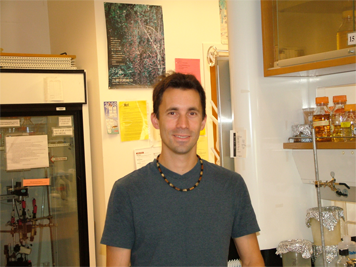
Position Title
Assistant Professor
- California Northstate University
- Molecular Genetics
- Appointment period: 4/1/2009 to 8/31/2009
- Award: California Breast Cancer Research Program (CBCRP) Postdoctoral Fellowship #15FB-0109 entitled "The Control of BRCA2 Mediated Homologous Recombination"
Project
The Role of DNA Polymerases Delta (δ) and Zeta (ζ) in Homologous Recombination in Humans
Hypothesis and Specific Aims
The development of cancer is dependent on multiple mutagenic events caused by DNA damage and defects in DNA replication. The efficient repair of DNA damage is essential in maintaining genome stability and preventing tumor formation. Homologous recombination is a DNA repair pathway involved in dealing with types of DNA damage that are particularly germane in cancer treatment including damage induced by ionizing radiation, interstrand crosslinking agents, and topoisomerase inhibitors. I propose to determine which human DNA polymerases are involved in homologous recombination. Specifically, the extension of heteroduplex DNA by DNA polymerase ζ and/or δ in preformed D-loop or during reconstituted recombination reactions will be examined. Particular attention will be paid to whether both polymerases function together possibly in a coordinated hand-off orchestrated by PCNA/RFC.
Background and Significance
DNA is damaged by a variety of endogenous (e.g. reactive oxygen species) and environmental (e.g. UV and ionizing radiation) agents (Lindahl 1993). The preservation of genome stability is dependent on the repair of DNA damage by DNA maintenance mechanisms, which include nucleotide- and base-excision repair, mismatch repair, non-homologous end-joining (NHEJ) and homologous recombination (HR) (Hoeijmakers 2001; Friedberg et al. 2005). HR functions in the template-dependent, high-fidelity repair of DNA single-stranded gaps, DNA double-strand breaks (DSBs), stalled/broken replication forks and interstrand crosslinks (ICLs). The mechanism of the repair of DSBs by HR is critical since a single unrepaired DSB is lethal (Bennett et al. 1993). Eukaryotes contain many repetitive elements that can lead to genome rearrangements when recombination occurs between them (Britten and Kohne 1968; Szankasi et al. 1986; Rothstein et al. 1987). Controlling HR in the human genome, which features a variety of repeats, is especially important given the fact that recombination between repetitive elements has been implicated in genomic instability associated with disease (Strout et al. 1998; Nakaya et al. 2004).
The initial steps of HR following a DSB are DNA strand invasion of a homologous sequence, followed by extension of heteroduplex DNA by DNA polymerases (Li and Heyer 2008). DNA strand invasion is mediated by the eukaryotic recombinase Rad51 in conjunction with other cofactors including the breast cancer tumor suppressor protein BRCA2 (Sung 1994; Wooster et al. 1995; Sharan et al. 1997; Chen et al. 1998; Marmorstein et al. 1998). Following strand invasion, recent evidence has suggested the translesion polymerase, Pol η, can extend heteroduplex DNA in vitro and in vivo (Kawamoto et al. 2005; McIlwraith et al. 2005). Surprisingly, Pol δ was shown not to extend heteroduplex DNA in vitro despite extensive genetic evidence supporting a role in HR (Giot et al. 1997; Maloisel et al. 2008). In addition, it has been proposed that Pol η and Pol δ are not the only DNA polymerases that can extend heteroduplex DNA (Rattray and Strathern 2005). Recently the low-fidelity translesion polymerase Pol ζ, composed of the REV3/REV7 heterodimer, was shown to be involved in DSB repair associated mutagenesis (Rattray et al. 2002) and extension of 3’ oligonucleotides with or without a mismatch (Yuan et al. 2000; Guo et al. 2001). Pol ζ was first discovered in 1971 (Lemontt 1971) and latter found to be a B-family DNA polymerase (Morrison et al. 1989; Nelson et al. 1996), which is highly conserved in many eukaryotes (Zhu and Zhang 2003). Although the precise role of Pol ζ in DSB repair remains unclear, more evidence is suggesting a role for Pol ζ in genome stability and possibly as a tumor suppressor (Brondello et al. 2008). Loss of the catalytic subunit of pol ζ, REV3, in mice leads to embryonic lethality with the cells showing an increase in DSBs and chromosome aberrations suggesting a critical role in genome stability during development (Bemark et al. 2000; Esposito et al. 2000; Wittschieben et al. 2000; Van Sloun et al. 2002). Cells that lack REV3 are sensitive to DNA damaging agents such as UV and IR, have reduced gene targeting that signals a decrease in HR, increased genome instability, increased translocations and are synthetically lethal with mutants in the RAD54 HR protein (Sakamoto et al. 2003; Sonoda et al. 2003; Lin et al. 2006; Wittschieben et al. 2006). Taken together these results suggest an intimate link between RAD51/BRCA2 HR and the polymerase function of Pol ζ.

